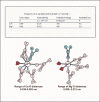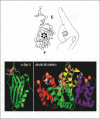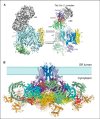Why Calcium? How Calcium Became the Best Communicator
- PMID: 27462077
- PMCID: PMC5076498
- DOI: 10.1074/jbc.R116.735894
Why Calcium? How Calcium Became the Best Communicator
Abstract
Calcium carries messages to virtually all important functions of cells. Although it was already active in unicellular organisms, its role became universally important after the transition to multicellular life. In this Minireview, we explore how calcium ended up in this privileged position. Most likely its unique coordination chemistry was a decisive factor as it makes its binding by complex molecules particularly easy even in the presence of large excesses of other cations, e.g. magnesium. Its free concentration within cells can thus be maintained at the very low levels demanded by the signaling function. A large cadre of proteins has evolved to bind or transport calcium. They all contribute to buffer it within cells, but a number of them also decode its message for the benefit of the target. The most important of these "calcium sensors" are the EF-hand proteins. Calcium is an ambivalent messenger. Although essential to the correct functioning of cell processes, if not carefully controlled spatially and temporally within cells, it generates variously severe cell dysfunctions, and even cell death.
Keywords: calcium; calcium ATPase; calcium channel; calcium signal; calcium transport; calcium-binding protein; calmodulin; magnesium.
© 2016 by The American Society for Biochemistry and Molecular Biology, Inc.
Figures




References
-
- El Albani A., Bengtson S., Canfield D. E., Bekker S., Macchiarelli R., Mazurier A., Hammarlund E. U., Boulvais P., Dupuis J.-J., Fontaine C., Fürsich F. T., Gauthier-Lafaye F., Janvier P., Javaux E., Ossa F. O., et al. (2010), Large colonial organisms with coordinated growth in oxygenated environments 2.1 Gyr ago. Nature 466, 100–104 - PubMed
-
- Strother P. K., Battison L., Brasier M. D., and Wellman C. H. (2011) Earth's earliest non-marine eukaryotes. Nature 473, 505–509 - PubMed
-
- Plattner H., and Verkhratsky A. (2015) The ancient roots of calcium signaling evolutionary tree. Cell Calcium 57, 123–132 - PubMed
-
- Williams R. J. P. (1999) Calcium: the developing role of its chemistry in biological evolution. In Calcium as a Cellular Regulator (Carafoli E, and Klee C., eds), pp. 3–27, Oxford University Press, New York
Publication types
MeSH terms
Substances
Associated data
- Actions
- Actions
- Actions
- Actions
LinkOut - more resources
Full Text Sources
Other Literature Sources

